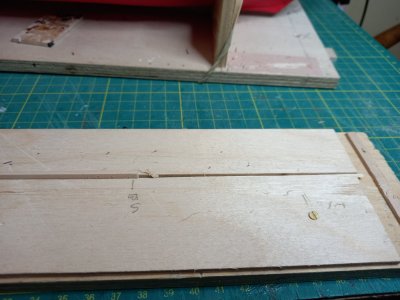Agreed, just don't undertake too many decisions after a couple beers. That seems to be when I am most decisive!I too am new to ship modeling, I find strip planking to be creative and subject to trial and error, requiring lots of patience and researching different techniques by experienced modelers on this forum, but like all craftsmanship endeavors the final reward is most satisfying, Darryl
-

Win a Free Custom Engraved Brass Coin!!!
As a way to introduce our brass coins to the community, we will raffle off a free coin during the month of August. Follow link ABOVE for instructions for entering.
You are using an out of date browser. It may not display this or other websites correctly.
You should upgrade or use an alternative browser.
You should upgrade or use an alternative browser.
Trim top of plank, or bottom?
- Thread starter BarnegatBay
- Start date
- Watchers 14
- Joined
- Apr 12, 2025
- Messages
- 282
- Points
- 158

That's very true. I think a 'Six-Pack' before making any tough decisions is a much better approach!Agreed, just don't undertake too many decisions after a couple beers. That seems to be when I am most decisive!

I do like Mr. Bronze said. It just makes sense - to me. But ... towards the end of a job, I find myself tapering both sides, of a plank or two.I always taper and chamfer the edge of the plank that will contact the previous plank so as to test the result in a dry fit. So "top" or "bottom" depends on which sequence I am adding planks.
1. Factually, there is probably no straight line anywhere on any plank on a model; everything is beveled one way or another.This concerns basic planking technique for POB kits with supplied planks. I am a beginner ship model maker.
I understand the basic technique of working out how much to trim off each plank along the bulkheads. Working through that now on my Mamoli Catalina kit.
However, I have two references for basic planking. One says ALWAYS trim off from the top of the plank; one says ALWAYS from the bottom.
Is one of these references wrong, or maybe it does not matter as long as you try to do it consistently.
I realize planking method is a large and complex part of the hobby with many approaches, but here I am just getting started and already getting two opposite directions.
Thanks for any advice.
2. Thus, you most likely are going to trim all four sides on all the planks until they fit all the time; one method used is called spiling - look it up.
3. There is a picture of a planking layout in this thread that gives you a pretty good idea of what the planks are going to look like depending upon their position on the hull. GOOD TO STUDY THIS PICTURE.
4. There is really no way to learn how to do this type of planking other than by just doing this type of planking. Forget the written descriptions in books; waste of time. Look at pictures of other models and pix of real sailing vessels; Model Seaways has all the picture books you will ever need - call them, they will help. This is an ART not Engineering,; there are no rules. You will need to develop your own "brush strokes" (so to speak). If you make an ill-fitting plank, throw it away and make another. Given a little time, you develop your own individual sort of rhythm.
5. Just an aside, delve into the world of wood scrapers (you make your own out of all kinds of shapes and sizes of metal). Hulls are best faired/finished with scrapers not sandpaper. I think it is safe to say that every plank on the model could benefit from a good scraping job.
6. Have fun!
BTW. Don't buy a commercial planking clamp: make one. The latest one I made is simply two strips of plywood fixed to a base with a gap that will just fit a plank onThis concerns basic planking technique for POB kits with supplied planks. I am a beginner ship model maker.
I understand the basic technique of working out how much to trim off each plank along the bulkheads. Working through that now on my Mamoli Catalina kit.
However, I have two references for basic planking. One says ALWAYS trim off from the top of the plank; one says ALWAYS from the bottom.
edge. The plank can easily be tapered/chamfered with a plane, spokeshave or even a file or scraper. Various measurements or points at which to start tapering can be scribbled on the surface.

Respectfully disagree Bill. For spiling the short essay by David Antscherl was enough to teach many of us how to properly shape a plank. PDF below. He is dead set against edge setting, but for those relegated to using strip stock this can be achieved with relative ease as shown in the 4 part Passaro video and I have found that is works extremely well.Forget the written descriptions in books; waste of time.
Attachments
- Joined
- Feb 15, 2019
- Messages
- 367
- Points
- 168

The accepted method is trim the bottom edge so you have a reguler even top edge to facilitate fitting the next plank.This concerns basic planking technique for POB kits with supplied planks. I am a beginner ship model maker.
I understand the basic technique of working out how much to trim off each plank along the bulkheads. Working through that now on my Mamoli Catalina kit.
However, I have two references for basic planking. One says ALWAYS trim off from the top of the plank; one says ALWAYS from the bottom.
Is one of these references wrong, or maybe it does not matter as long as you try to do it consistently.
I realize planking method is a large and complex part of the hobby with many approaches, but here I am just getting started and already getting two opposite directions.
Thanks for any advice.
Ho Boy, BarnegatBay, it’s always fun to see how a simple question can open the Pandora’s box of opinions especially on planking.
I am also a beginner and empathize so much with your situation. I spent years planking my first ship (the first layer came out horribly, and I stopped to practice on smaller models before starting the 2nd planking), and got so confused by information found online…
I am not good enough to want technical accuracy, I just want a hull that doesn’t have gaping holes and is pleasant to the eye. At this point my understanding is that: either you buy sheets of wood and spile it as mentioned above (have not yet tried that but believe it when people say it is easier than edge bending) or, you use the straight strips of woods provided by most kits, follow the good advice of Short John Bronze for tapering and chamfering… and unfortunately you have to rely on some edge bending at some point, I haven’t found another way (unless someone here can enlighten me). Chuck Passaro has good videos on how he does it, and I am currently trying to reproduce his technique.
I’m curious to hear the opinion of others on how to use the strips provided in kits!
Cheers!
I am also a beginner and empathize so much with your situation. I spent years planking my first ship (the first layer came out horribly, and I stopped to practice on smaller models before starting the 2nd planking), and got so confused by information found online…
I am not good enough to want technical accuracy, I just want a hull that doesn’t have gaping holes and is pleasant to the eye. At this point my understanding is that: either you buy sheets of wood and spile it as mentioned above (have not yet tried that but believe it when people say it is easier than edge bending) or, you use the straight strips of woods provided by most kits, follow the good advice of Short John Bronze for tapering and chamfering… and unfortunately you have to rely on some edge bending at some point, I haven’t found another way (unless someone here can enlighten me). Chuck Passaro has good videos on how he does it, and I am currently trying to reproduce his technique.
I’m curious to hear the opinion of others on how to use the strips provided in kits!
Cheers!
Among the many things I haven’t mastered yet is how to apply wood filler in a way that looks good… I always end up with unevenness in the surface, because sending sometimes removed chunks at a time (which leaves holes and dimples). Especially in areas of high curvature. I’ve been using a couple of different brands without a big difference. Does anyone have some advice?
I 'deactivated' a couple of 12 bore shells of no. 4 to add to my stock of cannonballs.Battle Damage.
Has anyone ever discharged a shotgun at a ship model to simulate battle damage? What calibre cannon corresponds to a shotgun pellet? Perhaps a risky experiment on a £1K model of HMS Victory to simulate her state at the end of Trafalgar.
The size of the pellet depends on both the scale and cannon size. A 32 pounder cannonball for example is about 6.1" At 1:64 scale this would be number 7 1/2 shot. A BB gun might be the ticket but likely too large diameter (0.177 - 4.5mm) It will penetrate about 1/16" (1.6mm)Battle Damage.
Has anyone ever discharged a shotgun at a ship model to simulate battle damage?
If the scale of the model is 1:72 such as the Caldercraft Victory, #9 shot would be about right but how to fire them? Maybe make your own small cannon with the right size diameter. We made little cannons with pieces of scrap iron and brass rods as kids and the ball would penetrate a tin can. Talk about shooting your eye out kid.
Allan
 "
"Bob, your opinion and commentary are greatly appreciated, especially for me the phenomenon of "at scale" viewing which plays into the viewer's perception of the model. As model scale decreases from 1:1 (the subject's actual size), even perfect detail is not possible for the viewer to perceive with their own eyes in any case. That is unless you have the machine from the movie 'Fantastic Voyage' to create the perfect 'scale model', and what would enjoyable about that?
Very interesting discussion prompted by my original elementary question about trimming planks.
What an enjoyable Forum (Ships of Scale) to participate in. Gives me a break from worrying about AI weakening our ability to think like humans.
As to the discussion on creating realistic model battle damage. Same concerns apply: at reduced scale, projectile damage is not going to be the same as real damage because the physics of wood and ballistics vary with scale. So only approximation to what the viewer perceives as 'realistic' damage is really possible to model anyway.
Best to all.
Very interesting discussion prompted by my original elementary question about trimming planks.
What an enjoyable Forum (Ships of Scale) to participate in. Gives me a break from worrying about AI weakening our ability to think like humans.
As to the discussion on creating realistic model battle damage. Same concerns apply: at reduced scale, projectile damage is not going to be the same as real damage because the physics of wood and ballistics vary with scale. So only approximation to what the viewer perceives as 'realistic' damage is really possible to model anyway.
Best to all.





